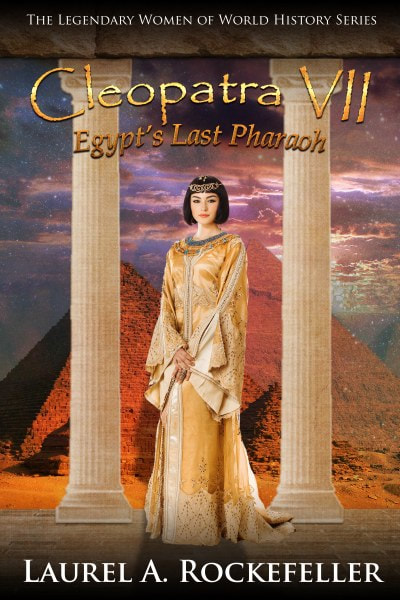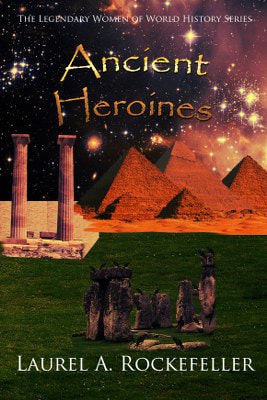Cleopatra
VII: Egypt's Last Pharaoh
The
Legendary Women of World History 9
by
Laurel A. Rockefeller
Genre:
Historical Fiction
The
exciting true story of Egypt's most famous queen!
Cleopatra
Thea Philopator refused to do what she was told. In an age where
patriarchy denied full citizenship to even the most elite of Roman
women, Cleopatra ruled her Egypt determined to keep it independent
and free from Roman control -- at any price necessary. Demonized as a
simple seductress by Gaius Julius Caesar Octavianus (the future
Caesar Augustus) and his political allies, Cleopatra VII proved
herself the equal to three of the most powerful men of the Roman
world: Gaius Julius Caesar, Marcus Antonius, and Octavian Caesar.
Includes
a detailed timeline, suggested reading list/bibliography, and a
special Easter egg for Doctor Who fans.
**Only
.99 cents on Amazon!**
Amazon
* Apple
* B&N
* Kobo
* Smashwords
Born,
raised, and educated in Lincoln, Nebraska USA Laurel A. Rockefeller
is author of over twenty books published and self-published since
August, 2012 and in languages ranging from Welsh to Spanish to
Chinese and everything in between. A dedicated scholar and
biographical historian, Ms. Rockefeller is passionate about education
and improving history literacy worldwide.
With
her lyrical writing style, Laurel's books are as beautiful to read as
they are informative.
In
her spare time, Laurel enjoys spending time with her cockatiels,
attending living history activities, travelling to historic places in
both the United States and United Kingdom, and watching classic
motion pictures and classic television series.
Website
* Facebook
* Twitter * Pinterest
* YouTube
* Amazon
* Goodreads
GUEST POST
GUEST POST
Five
Myths about Cleopatra VII
By
Laurel A. Rockefeller
Cleopatra VII is easily the most famous
woman of the ancient western world. Sly and sexy, beautiful beyond
compare, we celebrate her as much for her passionate love affairs as
we do her devotion to husband Marcus Antonius (Marc Antony). But are
these images of her true? In my latest biography, “Cleopatra VII:
Egypt’s Last Pharaoh” I sort fact from fiction to reveal the real
woman you thought knew. Here are five “facts” about her you will
discover are actually myths.
She was a sexy vixen.
Probably our most
potent image of Cleopatra is of a seductress who lured first Gaius
Julius Caesar, then his friend Marc Antony into her bed. The image is
historical, but not true. In this case we are the victim of a
politically-motivated public relations campaign started by Gaius
Julius Caesar Octavianus (the future Caesar Augustus) designed to
justify entering into yet another civil war, this time with Antony.
Octavian wanted to
rule the Roman Empire as emperor. Cleopatra VII and an independent
Egypt stood in the way of those plans. Just as politicians have
continued to do in the over 2000 years since, he accomplished his
goals by attacking Cleopatra’s character and painting her as a
one-dimensional, sex-craven vixen, a threat to everything good,
moral, and decent. That she was a woman daring to wield political
power instead of staying house-bound and pregnant made it all too
easy.
She was the most beautiful woman of
her age.
Going hand-in-hand
with the sexy seductress image, Octavian and his allies projected an
image that Cleopatra was the most beautiful woman in the world. With
such beauty, it would be easy to seduce any man she wanted. However,
this image too is not accurate—at least not if one is measuring
beauty according to the physical standards of the day.
Coinage from her reign and statuary indicate that she was modesty
attractive, but hardly a model beauty. Just like Anne Boleyn 1600
years later, Cleopatra’s beauty was grounded in her intelligence,
her wit, and her charm. She was beautiful first and foremost because
she was a beautiful person. Her physical attractiveness (which was
above average) came secondary.
She was in love with Marc Antony.
Hollywood has made
a lot of money off this image that Cleopatra and Marc Antony were
madly in love with each other. However, if one is to judge a person
based on actions and not the words of a political enemy, it becomes
very clear that Cleopatra was far less interested in Marc Antony than
he was with her. Did she care for him? Certainly. But she loved
Egypt more—much more. In this, Cleopatra was very much like Queen
Elizabeth of Tudor: married to her kingdom.
She died for love.
Dying for love
makes a great Hollywood ending for her life. However, for Cleopatra
it simply was not the case—nor was it for Marc Antony. Enemies of
the Roman Republic and later Roman Empire were taken alive if
possible and paraded as part of a victorious general’s Triumph
celebrations before being executed according to the whims of the
victor. Knowing this well, neither Antony nor Cleopatra wished to be
used and tortured in this fashion. They committed suicide to avoid
the disgrace and agony they both knew Octavian planned for them,
diminishing his victory.
She had only one child –
Caesarion.
Both Marc Antony
and Cleopatra were married several times and had several
love-affairs. Marc Antony had a son by his first wife Fulvia who was
executed along with Cleopatra’s eldest son Ptolemy Caesar
(nicknamed Caesarion), her bastard child with General Gaius Julius
Caesar. Antony and Cleopatra together had fraternal twins Alexander
Helios and Cleopatra Selene followed by their younger son, Ptolemy
Philadelphus. After their suicide, Octavian brought the three
children to Rome where they were raised with Antony’s two daughters
by wife Octavia.
Follow
the tour HERE
for exclusive excerpts, guest posts and a giveaway!










No comments:
Post a Comment